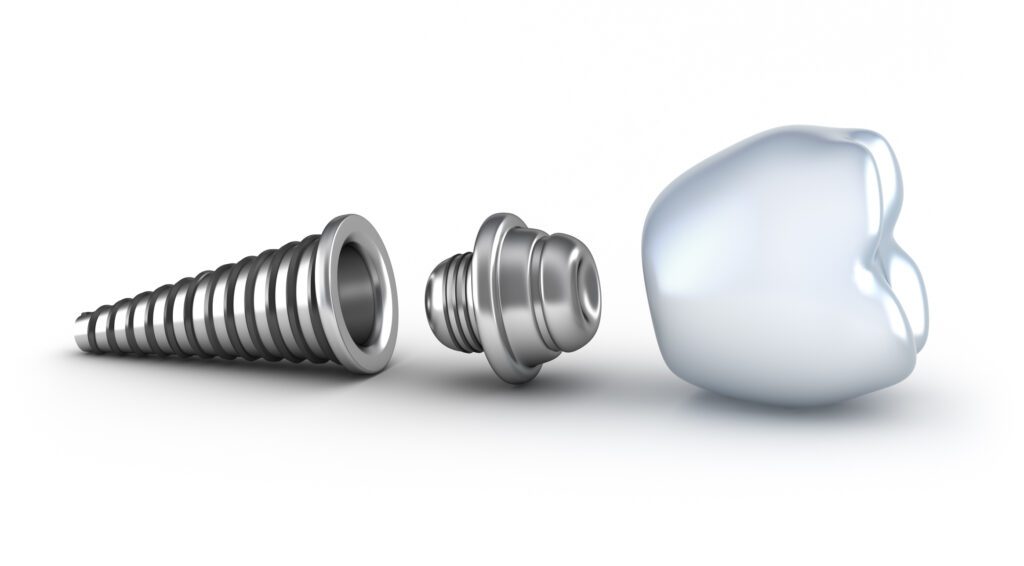The makeup of a dental implant restoration is complex. This tooth replacement option is unlike any option available today. Dr. Ray Becker explains the parts that make up dental implants in his Columbia, MD office.
What are Dental Implants?
Dental implants are a whole teeth replacement system that can replace any number of missing teeth. They’re made up of three separate parts, which operate almost like natural teeth together. The parts of a dental implant include an implant fixture, the abutment, and the final dental prosthesis.
Implant Fixture
The implant fixture is the part of the restoration that replaces the missing teeth roots and supports the prosthesis. Dental implant must be surgically inserted into the jaw bone. Dr. Becker will perform this part of the dental implant process in his office. Implants fixtures come in various sizes and materials.
The implant surgery
The implant surgery is fairly easy. You will be given local anesthesia to numb the area around where the implant will be placed. Is some cases, general anesthesia will also be used especially if multiple dental implants are being placed.
Dr. Becker will make a small incision in the gums to access the bone. He will create a small hole to carefully insert the implant into the bone. The last step is to stitch up the gums or secure an abutment. A single implant will take about 1 -2 hours to place but a complex case with multiple implants may require a longer surgical time.
The different sizes of implants
Dental implants come in three basic sizes: standard, mini, and wide. Most cases will use a standard implant, which measures between 3.5 mm to 4.3 mm wide in diameter. But we may use a mini or wide implant in some cases.
A mini dental implant is only 2 mm to 3.5 mm wide in diameter. It is necessary to use it when there is little space between teeth roots or with patients who lack bone mass. A wide dental implant has a diameter of 4.5 mm – 6mm. They are necessary when patients are placing larger teeth with more expansive root systems such as the teeth in the back of the mouth.
Implant materials
Most dental implants are made of titanium. This type of metal is tested, predictable, and safe. It is biocompatible which means the human body accepts it. Many types of replacement body parts are made of titanium. Human bone can fuse to the surface it creating a very strong bond. Titanium is very lightweight but also very strong. Along with being highly corrosion resistant, it will literally last for a very long time.
Titanium is a metal, and some patients are allergic to metal. For this reason, many dentists may suggest zirconia dental implants. The post is also biocompatible and resistant to corrosion. Zirconia implants are also resistant to bacteria.
Abutment
The abutment is a crucial component of the restoration. It is responsible for connecting the dental implant to the artificial tooth or teeth. There are prefabricated abutments available Dr. Becker can use, or we can custom-make one to fit your tooth or teeth perfectly.
In most cases, it is better to take the time to have a custom abutment created. They are more expensive and will add some time to your treatment. However, using a stock abutment is a way to save time and money but will offer little customization.
Placing the abutment (the small connector that holds your new tooth) can happen in one of two ways. It depends on what’s best for your treatment plan.
- One-Stage Surgery: In this type of surgery, Dr. Becker places both the dental implant and a healing abutment at the same time. The healing abutment sticks out a little above the gums and helps the gum tissue heal around it. After the implant has fully joined with the bone (this is called “fusing”), he removes the healing abutment and replaces it with a permanent one that will hold your new tooth.
- Two-Stage Surgery: In this case, Dr. Becker places the dental implant and then stitches the gums closed over it. After the implant has fused with the bone, you’ll come back for a second surgery. At that time, Dr. Becker will open the gum and place the abutment.
Final Dental Prosthesis
The part of your dental implant restoration is the false teeth. The kind of prosthesis you will get depends on the number of teeth you are missing and where they are located in your mouth.
Dr. Becker will take impressions, measurements, and X-rays if needed to make sure your new teeth fit perfectly in your mouth. It typically takes two weeks for a dental lab to fabricate your permanent prosthesis. You may get one of the following:
- Dental Crown: If you’re missing just one tooth, our dentist may recommend dental crowns. A crown is a tooth-shaped cap that we place over a single dental implant. It looks and works just like a real tooth.
- Dental Bridge: A dental bridge might be the right choice if you’re missing several teeth in a row. At least two dental implants will support the bridge and will fill in the space left by your missing teeth. It gives you back the ability to chew and speak comfortably.
- Denture: If you’ve lost all your teeth on the top or bottom of your mouth (called an arch), our dentist may suggest a custom denture. This denture is attached to four to eight dental implants to hold it firmly in place. It won’t slip or move like traditional dentures can.
Request an Implant Consultation
Do you need to replace one or more missing teeth? You could be a good candidate for dental implants. Schedule a consultation with Dr. Becker in Columbia, MD, to learn more about dental implants and how they work. You can request an appointment online by filling out the form.
Learn more by using these links on our website:
